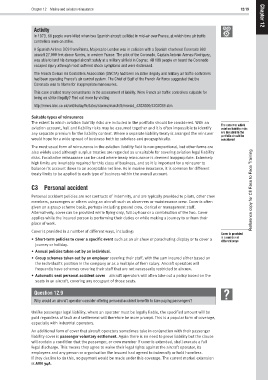Page 349 - M97TB9_2018-19_[low-res]_F2F_Neat2
P. 349
Chapter 12 Marine and aviation reinsurance 12/19 Chapter
Activity 12
In 1973, 68 people were killed when two Spanish aircraft collided in mid-air over France, at which time air traffic
controllers were on strike.
A Spanish Airlines DC9 from Palma, Majorca to London was in collision with a Spanish chartered Coronado 990
aircraft 27,000 feet above Nantes, in western France. The pilot of the Coronado, Captain Antonio Arenas-Rodriguez,
was able to land his damaged aircraft safely at a military airfield in Cognac. All 108 people on board the Coronado
escaped injury although most suffered shock symptoms and were distressed.
The French Civilian Air Controllers Association (SNCTA) had been on strike illegally and military air traffic controllers
had been operating France’s air control system. The Chief of Staff of the French Air Force suggested that the
Coronado was to blame for inappropriate manoeuvres.
This case created many conundrums in the assessment of liability. Were French air traffic controllers culpable for
being on strike illegally? Find out more by visiting:
http://news.bbc.co.uk/onthisday/hi/dates/stories/march/5/newsid_4202000/4202039.stm.
Suitable types of reinsurance
The extent to which aviation liability risks are included in the portfolio should be considered. With an
The extent to which
aviation account, hull and liability risks may be assumed together and it is often impossible to identify aviation liability risks
any separate premium for the liability content. Where a separate liability treaty is arranged the reinsurer are included in the
portfolio should be
would hope for a wide spread of business both by subclass and geographically. considered
The most usual form of reinsurance in the aviation liability field is non-proportional, but other forms are
also widely used although surplus treaties are regarded as unsuitable for covering aviation legal liability
risks. Facultative reinsurance can be used where treaty reinsurance is deemed inappropriate. Extremely
high limits are invariably required for this class of business, and so it is important for a reinsurer to
balance its account down to an acceptable net line. As in marine insurance, it is common for different
treaty limits to be applied to each type of business within the overall account.
C3 Personal accident Reference copy for CII Face to Face Training
Personal accident policies are not contracts of indemnity, and are typically provided to pilots, other crew
members, passengers or others using an aircraft such as observers or maintenance crew. Cover is often
given on a group scheme basis, perhaps including ground crew, clerical or management staff.
Alternatively, cover can be provided while flying only, full 24-hour or a combination of the two. Cover
applies while the insured person is performing their duties or while making a journey to or from their
place of work.
Cover is provided in a number of different ways, including:
Cover is provided
in a number of
• Short-term policies to cover a specific event such as an air show or parachuting display or to cover a
different ways
journey or holiday.
• Annual policies taken out by an individual.
• Group schemes taken out by an employer covering their staff, with the sum insured either based on
the individual’s position in the company or as a multiple of their salary. Aircraft operators will
frequently have schemes covering their staff that are not necessarily restricted to aircrew.
• Automatic seat personal accident cover – aircraft operators will often take out a policy based on the
seats in an aircraft, covering any occupant of those seats.
Question 12.9
Why would an aircraft operator consider offering personal accident benefits to fare-paying passengers?
Unlike passenger legal liability, where an operator must be legally liable, the specified amount will be
paid regardless of fault and settlement will therefore be more prompt. This is a popular form of coverage,
especially with industrial operators.
An additional form of cover that aircraft operators sometimes take in conjunction with their passenger
liability cover is passenger voluntary settlement. Again there is no need to prove liability but the clause
will contain a condition that the passenger, or crew member if cover is extended, shall execute a full
legal discharge. This means they agree to waive their legal rights against the aircraft operator, its
employees and any person or organisation the insured had agreed to indemnify or hold harmless.
If they decline to do this, no payment would be made under this coverage. The current market extension
is AVN 34A.

